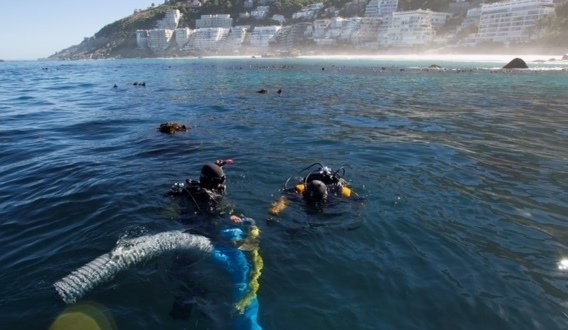Wreck of slave ship Sao Jose-Paquete de Africa found off Cape Town.
Long-buried artifacts from a 200-year-old slave ship recently found off the coast of South Africa will be displayed next year at the Smithsonian’s National Museum of African American History and Culture. The artifacts, which will be on a 10-year loan to the museum, are thought to be the first ever recovered from a slave ship wrecked while transporting enslaved people.
Two of the objects from the wreck of the São José-Paquete de Africa, a Portuguese ship en route to Brazil while carrying more than 400 enslaved people from Mozambique in December 1794, are to be unveiled Tuesday at a news conference in Cape Town. The iron ballast used to offset the relatively light weight of the ship’s human cargo and a wooden pulley block will also go on view when the new African American History Museum opens on the National Mall in Washington, D.C., in the fall of 2016.
Museum officials say they hope to find more objects from the dive site, where an international team of investigators from museums and research institutions in the United States and Africa has been quietly working on the project since 2010.
“We hope to have shackles,” said Lonnie G. Bunch III, the founding director of the new museum. “What I’m really hoping for, and we’re still trying to make sure that we’ve got, is a piece of wood from the hull of the ship where the enslaved people were held.”
Having the items, Bunch says, “will help people get a better understanding of the slave trade.”
More than 400,000 slaves
The story of the São José is one that gives insight into the early days of shipping East Africans in the trans-Atlantic slave trade, a practice that would continue well into the 19th century. More than 400,000 East Africans are estimated to have made the months-long journey from Mozambique to Brazil between 1800 and 1865.
Until now, researchers have never been able to conduct an archaeological investigation on a vessel that was lost while carrying human cargo. The investigation could provide new scholarship in the study of the global slave trade. And this particular ship, according to reports, is important to historians because it dates to one of the earliest attempts to bring captured East Africans into the trans-Atlantic slave trade, a pivotal moment that prolonged the slave trade for decades.
The wreck, just 60 meters off the rocky coast of the Cape, was originally found by treasure hunters in the 1980s who misidentified it as an earlier Dutch ship. Because of South African regulations at the time, they had to file details of their dive with the government. That information, paired with newly found accounts of the wreck by the captain of the São José, led to new dives, which turned up copper fastenings and copper sheathing that indicated a wreck of a later period.
What made the site a dangerous place for 18th-century ships is what makes it difficult for divers today, says Paul Gardullo, a curator at the African American History Museum and its chief representative to the Ship Wrecks Project. More than 200 of the enslaved Africans were lost at the crash site, a place so close to the shore the crew was able to shoot a cannon after hitting the rocks to signal for help. “The captain and all the crew were rescued, as well as about half of those who were enslaved on board,” Gardullo says. “And the other half of whom tried to save themselves” but drowned. The Mozambique people rescued were likely re-enslaved on a subsequent voyage to Brazil, he says.
The story of the São José is one that gives insight into the early days of shipping East Africans in the trans-Atlantic slave trade, a practice that would continue well into the 19th century. More than 400,000 East Africans are estimated to have made the months-long journey from Mozambique to Brazil between 1800 and 1865.
Agencies/Canadajournal

 Canada Journal – News of the World Articles and videos to bring you the biggest Canadian news stories from across the country every day
Canada Journal – News of the World Articles and videos to bring you the biggest Canadian news stories from across the country every day

